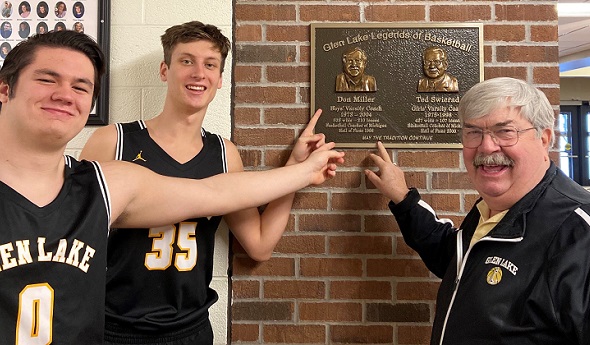
Miller's Mentoring Spans Into 7th Decade
January 29, 2020
By Mike Spencer
Special for Second Half
MAPLE CITY – With the dawn this winter of the 2020s, Don Miller is coaching high school basketball in a seventh decade.
 That’s rarefied air in Michigan High School Athletic Association circles, but it’s an atmosphere the 73-year-old longtime Maple City Glen Lake basketball coach has enjoyed and plans to continue as long as his health, family and Laker nation lets him.
That’s rarefied air in Michigan High School Athletic Association circles, but it’s an atmosphere the 73-year-old longtime Maple City Glen Lake basketball coach has enjoyed and plans to continue as long as his health, family and Laker nation lets him.
“I have a passion for the bouncing of balls in a gym,” said Miller, who made his coaching debut at Howell in 1969 but then spent five decades guiding the Lakers’ ship. “The worst headache I may have disappears with that sound as I walk into a gym. The blood pressure goes down and the pleasure goes up – practices or games.”
Miller, admittedly the last man on his varsity basketball team at Southfield High during his playing days, coached a lot of good teams and players at Glen Lake during his varsity tenure (1973-2004) when he posted a 523-210 record.
“I didn’t have a lot of basketball skill, but I was a basketball junkie who got the bug to coach and I got better over the years,” Miller said. “I never scored a basket over the years, but I had a lot of players who made me look good. The kids loved the game and had the passion, and we had a spinning wheel of success breeding success.”
A Michigan State University grad, Miller enjoyed watching the Spartans practice after classes, although he never could have forecasted he’d become a Basketball Coaches Association of Michigan (BCAM) Hall of Famer in 1998 or enjoy decades of leading drills.
“Basketball is all about great chemistry, and being with young people sharing a game we love is just wonderful,” Miller said. “And to be able to do it this long is a gift, not a job. I am truly blessed to be in a gym for three hours a day.”
Today, there’s just a handful of active MHSAA coaches with Miller’s experience. Ironically, one of them is Beaverton’s Roy Johnston. Miller was an assistant of Johnston’s back in the early 1970s.
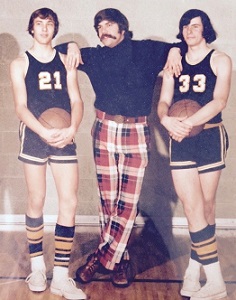 “I’m shocked to see Don still coaching,” said Cody Inglis, a former Suttons Bay athletic director/coach who worked Miller’s camps for a decade and went on to serve as athletic director at Traverse City Central and currently as an MHSAA assistant director. “But it shows that if there’s something you are good at, and something that you are passionate about, that you are never too old to do it.
“I’m shocked to see Don still coaching,” said Cody Inglis, a former Suttons Bay athletic director/coach who worked Miller’s camps for a decade and went on to serve as athletic director at Traverse City Central and currently as an MHSAA assistant director. “But it shows that if there’s something you are good at, and something that you are passionate about, that you are never too old to do it.
“Don’s been a wonderful role model for coaching, perseverance and doing it the right way.”
Former player Todd Ciolek, who also has had a child play for Miller, concurred.
“It’s pretty amazing,” Ciolek said of Miller’s tenure. “But when you have a love for something, it makes it easy to do. For him, he’s got a love for this and I think it comes naturally.”
Miller guided the Lakers boys team to the Class D title in 1977 and runner-up finish in 1996. His teams also reached the MHSAA Semifinals twice. His teams won six Regionals, 16 Districts and 14 conference titles.
He stepped down as Glen Lake’s main man after the 2004 season due to health issues, needing a pacemaker and a stent. He continued running his summer basketball camps and became a volunteer assistant coach for former all-state player Todd Hazelton in 2007.
When Rich Ruelas became head coach in 2015, he asked Miller to be his junior varsity coach. Miller did that for three seasons and is now an assistant varsity coach.
“I was reborn!” Miller said. “I don’t eat and sleep basketball like I used to, but I love my three hours each day with these young men who share this common passion. It’s been a lifesaver.
“My role is advisor and listener,” he added. “But watching Rich, he’s me 30 years ago. I love feeding off his intensity.”
“I truly enjoy having Coach Miller as part of the program that he helped build,” Ruelas said. “There is nothing he hasn't gone through as a coach, and I have relied on him for advice over the past five years.
“He just knows the game so well and has made such an impact on the lives of his former players and campers with his ability to teach life lessons through basketball. We are lucky to have a Hall of Fame coach as part of our program, and I don't take it for granted.”
Ruelas and Miller, a retired educator, not only get together three hours in a gym daily, they routinely have “Mornings with Miller,” on the phone as Ruelas makes his 30-minute commute to school.
Ruelas said Miller has already given him some memorable moments – the unbeaten junior varsity team in 2018 that Miller coached, assistance with the Lakers’ 2018 Finals run (Glen Lake finished Class C runner-up) and an opportunity to meet MSU coach Tom Izzo.
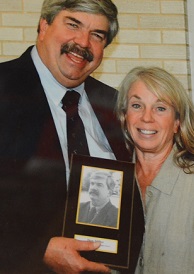 “What sticks out to me most is that we cannot go anywhere in the state without Don running into a former camper or player,” Ruelas said. “He has made such a lasting impact on so many, and it is evident in his relationships with his former players over the past seven decades.
“What sticks out to me most is that we cannot go anywhere in the state without Don running into a former camper or player,” Ruelas said. “He has made such a lasting impact on so many, and it is evident in his relationships with his former players over the past seven decades.
“I'm not sure how long he will continue to be on the bench with me, but I know he still has a lot of fire in his belly. As long as he has permission from his wife and is able, I expect him to be there.”
One of Miller’s trademarks is teaching life lessons first and basketball second.
“Don was a unique coach,” Ciolek said. “He wasn’t a coach of basketball first; he was a coach of ethics and morals and basketball came second.
“Most coaches start with some technique, but he started with the word respect and then engrained in us that there was more beyond basketball. He instilled a set of values in us that ultimately led to victories.”
While Miller has had decades of success, some of the losses were devastating.
“You remember the losses more than the wins, and three last-second losses are forever etched in my brain,” said Miller noting a 1978 loss to Mio and Jay Smith in the Regional Final at Gaylord, a buzzer-beating in 1988 by eventual Class D champ Northport and the 1996 Semifinal loss to Wyoming Tri-unity Christian. “The pain and tears and disappointment of these three were great memories. But losses are part of the game and the boys, now men on those teams, have made me very proud ever since.”
Miller said he’s seen a lot of things change for the better since he started coaching. Players are starting younger and getting better coaching earlier, and that has led to improved talent and team play. There are also nicer gyms and uniforms, and Miller loves the idea of boys sharing the spotlight with girls programs.
His disdains, however, are that larger schools today have kids who tend to specialize in one sport earlier, and the crowd of negative parents is growing.
“Our kids play several sports, and I feel it makes them better,” Miller said. “Playing for other coaches in other sports increases competitiveness and team play. You learn to be a different role player, and that carries over into life. “
Miller said credit for his decades of success goes to his supportive wife, Sandy, and the blind luck of having Paul Christiansen as his first junior varsity coach.
“Paul was my organizer, critic, conscience and cohort for three decades,” Miller said. “He is a Hall of Fame track coach but the real wind beneath my wings. None of this happens without Paul.”
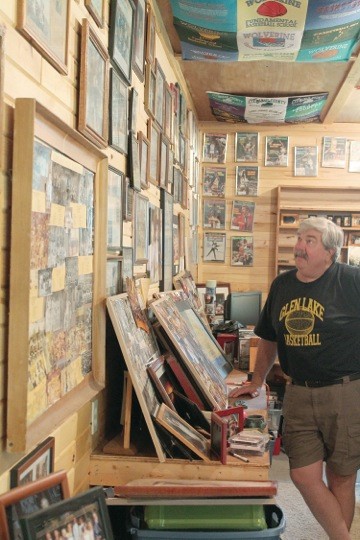 Both Miller and Christiansen were honored by BCAM in 1998, with Miller going into the HOF and Christiansen going into the Hall of Honor.
Both Miller and Christiansen were honored by BCAM in 1998, with Miller going into the HOF and Christiansen going into the Hall of Honor.
Miller also credits a number of coaching mentors including the late Larry Glass, a former Big Ten men’s coach and girls basketball coach at Leland, and great players and coaches he recruited to help at his summer camps in Wolverine and Glen Lake.
While Miller savors the friendships with other coaches, he’ll forever cherish his former players, who reciprocated their love by building him a man cave and basketball museum after he retired in 2004 and show up for weekly games of basketball at the Glen Arbor Town Hall – a 40-year-old tradition – with fellowship afterward.
“They call, email and treat me to meals out which really is too bad for my figure but great for my ego and friendships,” Miller admitted. “I love my boys (now men) and for that, I am truly the luckiest.”
“I was fortunate enough to be coached by Don when he was just starting out at Howell,” said Tom Murray, former Bay City John Glenn and Standish-Sterling Central coach. “He changed my life and many of my classmate’s lives.
“Don’s touched so many lives, it’s incredible. He instilled a lifelong love of basketball in me. He is a fantastic coach and man.”
Mike Spencer is a former MHSAA referee and sportswriter for the Bay City Times, Midland Daily News and Leelanau Enterprise and freelancer for both the Enterprise and the Traverse City Record Eagle.
Seven Decades of Miller Highlights
1960s – Last man on the Southfield High team. Watching MSU practice after class without a clue that he would coach someday. Getting hired in 1969 as the freshman coach at Howell because no else wanted the job and coaching Morey Ray, his first great player.
1970s – Coaching the 1977 Class D championship season and the slow evolution over the years of the front line of seniors Dave Prentice, Geof Kotila and Rick Baillergeon, who started for three years. Being down three points, without the ball and 30 seconds to go, and winning the Final by two on a shot with one second left against the No. 1-ranked team in the state, Detroit East Catholic, 70-68.
1980s – Keeping the ball rolling and seeing four of those starters – from the 1977 and 1978 teams – become captains of a college team. Reaching the quarters in 1980, the semis in 1981, 1984 and 1985. Standouts included Bob Sutherland (’80), Bill Zolman and Kevin Crinion (’81), Ron Winowiecki and Dan Witkowski (’84), and Mike Crinion and Ross Hazelton (’85). Beating No. 1 Bear Lake at Traverse City Central in front of 2,800 fans – “Loudest gym. Teamwork over talent and Mike Crinion was amazing.”
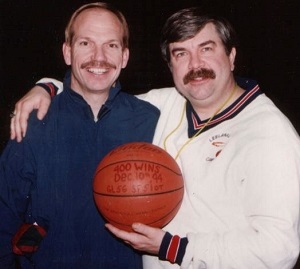 1990s – Keeping ball rolling as elementary kids became high school stars. Reaching the quarters in 1991 and 1995 and semis in 1996. Standouts included Micah Deegan and Bryan Fosmore (’91), Todd Ciolek and Max Miller (’95), and Jamie Mazurek and Greg Aylsworth (‘96). Semifinal upset of reigning Class D champ Detroit Holy Redeemer, 81-66.
1990s – Keeping ball rolling as elementary kids became high school stars. Reaching the quarters in 1991 and 1995 and semis in 1996. Standouts included Micah Deegan and Bryan Fosmore (’91), Todd Ciolek and Max Miller (’95), and Jamie Mazurek and Greg Aylsworth (‘96). Semifinal upset of reigning Class D champ Detroit Holy Redeemer, 81-66.
2000s – Retired in 2004, but with recent adoring memories of 2002 league and District championship team led by Chris Milliron and Steve Walker. Team showed great improvement in ability and attitude, avenging losses to Suttons Bay and Traverse City St. Francis with 24-point victories.
2010s – Returned in 2015 as assistant coach to Rich Ruelas and coached the boys junior varsity to 55-5 record over his first two seasons with three sophomores and a freshman on the varsity. Posted two 20-0 seasons.
2020 – Still coaching as an assistant.
PHOTOS: (Top) Glen Lake assistant boys basketball coach Don Miller, with captains Ben Kroll (left) and Reece Hazelton, point to the plaque declaring his legendary status in the program. (2) Miller confers with a pair of players during the 1977 Class D championship season. (3) Miller and his wife Sandy. (4) Miller stands among the many mementos decorating his basketball museum built by former players. (5) Miller stands with longtime assistant Paul Christiansen, holding a ball commemorating Miller’s 400th coaching win in 1994. (Photos courtesy of Don Miller and the Leelanau Enterprise.)

63-Pointer Stirs Memories of UP Legends
February 29, 2020
By Ron Pesch
Special for Second Half
For the first time since 1970 – 50 years ago – and for only the 10th time in Upper Peninsula boys basketball history, a player has scored 60 or more points in a single game.
And that Houghton showing has stoked memories of legendary U.P. scoring showcases going back more than a century.
For the first time, the effort was for naught, at least from a win-loss standpoint, as Houghton dropped a nonconference road contest to Ishpeming 88-83 on Feb. 4. Brad Simonsen hit 23 of 45 field goal attempts, including 7 of 18 from beyond the 3-point arc, as Houghton pushed the play, hoping to narrow what had been a 10-point halftime margin. The 6-foot-6 senior, signed by Michigan Tech, was 10 of 13 from the free throw line and scored 24 points in the fourth quarter, ending the night with 63.
The performance topped Houghton’s school record of 60 points, set by Gary Lange in 1970. The total ranks 14th across the entire state for single game points in a contest, and tied Simonsen for sixth highest above the bridge. There, the mark equaled the top single-game output posted by Stephenson’s Mel Peterson, considered by many the greatest cager ever to come out of the Upper Peninsula.
“Marvelous Mel”
Peterson was the son of a minister and one of 10 children (and eight boys). His older brother, George, broke the U.P. scoring record in 1949 with 44 points in a game for Stephenson High School. The family moved away from the Upper Peninsula following George’s graduation, ultimately landing in southeastern Idaho.
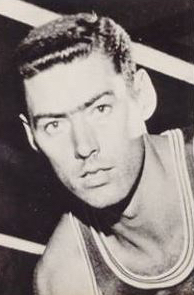 There, Mel emerged as an outstanding athlete for Idaho Falls High School. Standing 6-foot-4½, Peterson’s growth occurred mostly during his freshman year.
There, Mel emerged as an outstanding athlete for Idaho Falls High School. Standing 6-foot-4½, Peterson’s growth occurred mostly during his freshman year.
“I played quite a bit on the varsity my sophomore year,” recalled Peterson recently. “My junior year I started out very, very slow but ended up very good. (However,) I fractured my ankle with about a minute to go in the semifinals of the (1955) state tournament, which we won.”
Peterson led all scorers with 25 points and dominated the boards that night, but had to be helped from the floor, then didn’t play in the title contest. “We lost the state tournament by three points, (43-40 to Kellogg). I was a cheerleader. … It would have been fun to play in the final game.”
When his father received a call to serve the Mission Covenant Church in Wallace, Michigan, about seven miles south of Stephenson, the family returned to the Upper Peninsula for Peterson’s senior year.
“At that time, it was nothing like it is now, where you can find anything about anybody. Then, that wasn’t the case at all,” Peterson said. “So, when we came back, no one had any idea of where I lived before, if I played or not.”
Indeed, prior to football season, one newspaper report indicated Peterson had transferred in from North Dakota, while another listed him as coming from Illinois. Regardless, Peterson emerged as a solid football player at Stephenson High in the fall of 1955. But it was on the basketball court where his scoring and rebounding prowess quickly loomed. He opened the season with 33 points in a win over Gladstone, despite fouling out early in the fourth quarter.
By January, the media had taken to calling him “Marvelous Mel” as Peterson averaged 32.3 points in his first half-dozen games for the Eagles. He drove Stephenson to a 15-1 regular-season record, posting 11 games over 30 points and scoring more than 40 in six.
On Jan. 21, 1956, he poured in 63 points in an 89-44 win over Manistique, shattering his brother’s school record. Mel nailed 25 of 38 shots from the field and 13 of 16 from the free-throw line. At the time, the scoring total exceeded the previous known best in the U.P. of 60 points, scored by Norbert Purol in February 1952. (Purol, from Ironwood St. Ambrose, would later play two seasons of AAU ball in Chicago before matriculating at Kentucky Wesleyan, earning four letters between 1956 and 1959. Wesleyan ended the 1957 season as runner-up to Wheaton College in the inaugural NCAA Small College Tournament – now known as Division II.)
“I don’t remember a great deal about a lot of it. That was so long ago,” said Peterson, laughing. “I guess the thing I appreciate most about the game was that my coach (Duane “Gus” Lord), let me play the whole game, which didn’t happen real often. Probably the thing I remember most about the whole year is that we played a Catholic school, Lourdes, from Marinette, Wisconsin. The first game we played them we beat them 110 to 44. The second game we lost 68-66.”
Peterson’s regular-season total of 570 points also exceeded Purol’s U.P. record of 556 posted over 19 games in 1952. His regular-season average, which had climbed to 35.6, topped the previous best of 29.6, posted by Pete Kutches in 1952 for Escanaba St. Joseph. Then Peterson pushed the per-game-average even higher in the postseason.
Seeing more playing time in the playoffs, “Marvelous Mel,” notched more than 30 points in all seven postseason games (exceeding 40 in three of the contests and 50 once), leading Stephenson to the MHSAA Class B championship win against Detroit St. Andrews in sudden-death overtime, 73-71. There he scored the game-tying bucket with 17 seconds remaining in the three-minute extra frame, and then sunk the game winner 26 seconds into sudden death, where the first team to gain a two-point advantage was proclaimed the victor. That 1956 season saw three of the four basketball championships awarded to U.P. teams.
Peterson finished with 849 points on the year – at the time the best single-season performance in MHSAA history. He averaged 36.9 points across 23 contests – currently eighth in the MHSAA record book.
Following graduation, Peterson nearly signed to play at the University of Minnesota, but felt a better fit at Wheaton College, outside Chicago. There, he earned three All-American honors. As a freshman in 1957, he led Wheaton to victory in that first NCAA Small College Tournament championship game against Wesleyan, earning Most Outstanding Player honors along the way. Today, he remains Wheaton’s all-time leader in career points, points per game, field goals made and career rebounds, all accomplished “without the benefit of a 3-point line, which had yet to be implemented.”
Peterson, who helped the USA team win gold at the 1963 Pan American Games in Sao Paulo, Brazil, played two games for Baltimore in the National Basketball Association (NBA) before a heart condition sidetracked his career. Once the issue was repaired, he returned to play 134 games over three seasons in the American Basketball Association, earning an ABA league championship with the Oakland Oaks in 1969. In 2019, he was inducted into the Small College Basketball National Hall of Fame.
The High-Scoring Sixties
Roger Roell, a senior at Channing, topped Peterson’s U.P. single game record with a 67-point performance in early January 1960 by dropping 31 field goals and five free throws in a 105-55 win over Michigamme.
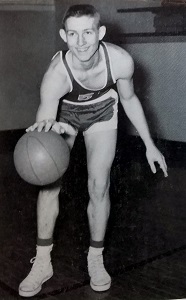 Just over seven weeks later, Jim Manning scored 69 for Trout Creek against Amasa in another lopsided affair, 140-47 (then, a U.P. record for highest team score. The team’s 44 points in the fourth quarter was also a U.P. mark at the time. Trout Creek’s coach, Bruce Warren began substituting in the second quarter).
Just over seven weeks later, Jim Manning scored 69 for Trout Creek against Amasa in another lopsided affair, 140-47 (then, a U.P. record for highest team score. The team’s 44 points in the fourth quarter was also a U.P. mark at the time. Trout Creek’s coach, Bruce Warren began substituting in the second quarter).
Manning, a junior, finished the 1959-60 season as the first player in U.P. history to exceed 600 points in one regular season, totaling 608 over 18 games. He would later pitch in the Major Leagues.
Roell finished second with 569 points in 18 regular-season contests. Third on the regular-season scoring list was another junior, Erwin Scholtz of Hermansville, who tallied 505 across 18 games.
As a senior, the 6-foot-5 Scholtz would post 71 points against Channing, a new benchmark for points in a game in the Upper Peninsula.
Or was it?
The Master’s Thesis
Perhaps because of the media coverage of Scholtz’s accomplishment, in 1962 the Crystal Falls Diamond Drill ran an article detailing the recently unearthed exploits of Ed Burling some 50 years prior. Richard Mettlach, football and baseball coach at Crystal Falls, had uncovered the Burling story.
Mettlach, “in the process of preparing a history of local high school sports which he submitted as a part of the preparation for his master’s degree … discovered that the newspaper records of the early years of high school basketball tell of a match between Iron River and Crystal Falls (played during the 1910-11 season).”
Crystal Falls had downed Iron River, 107-27, according to Mettlach’s research, and Burling had scored all but 10 of Crystal Falls’ points.
“Basketball was different in those days,” said Burling when interviewed by the Diamond Drill in January 1962. Then 68 years old and working as the postmaster in Crystal Falls, he recalled, “when one man was hitting the basket well, the rest of the team fed him the ball and let him shoot. I couldn’t miss that night.”
According to the article, “Burling said as he recalled the game, he made 98 points that night. It appears that 97, however, reportedly verified in two newspaper accounts of the game, will have to be the figure used in the record book.”
Burling recalled that the majority of his shots were from in front of the basket and that rules of the day allowed the top shooter on the team to attempt the free throws.
“The 97 point scoring record would probably have never been uncovered if it had not been for Mettlach’s research,” added the Diamond Drill.
Three more U.P. additions
In 1966, Bob Gale of Trout Creek scored 60 against Mercer, Wisconsin. Gale would later play at Michigan State.
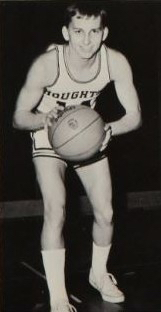 Houghton’s Lange scored his 60 as the Gremlins walloped Painsedale Jeffers, 134-62, on January 23, 1970. One week later, Larry Laitala dropped 65 as Champion crushed Felch, 114-71.
Houghton’s Lange scored his 60 as the Gremlins walloped Painsedale Jeffers, 134-62, on January 23, 1970. One week later, Larry Laitala dropped 65 as Champion crushed Felch, 114-71.
“We had a very good team that year. We had a lot of wings and normally, I wouldn’t play the whole game. My coach was Dominic Jacobetti (who played at Negaunee St. Paul, then Northern Michigan University) and he was a pretty prolific scorer in the U.P. It was one of those nights where the rim was real big,” recalled Laitala, chuckling.
Laitala finished second to Lange in regular-season scoring, 557 to 523, with each athlete playing 17 games.
“Houghton is possibly the best team in any class in the Upper Peninsula,” wrote Hal Schram in the Detroit Free Press, who predicted an MHSAA state title for the team noting that many felt Lange was the top player north of the bridge. The Gremlins, at 17-0, finished as the top-ranked team in Class C in the weekly press polls assembled by the Free Press, The Associated Press and United Press International.
But the season ended earlier than expected for both teams. Houghton fell to St. Ignace in a Regional Semifinal.
“We were beat by our archrival, Republic (61-55) in the first game of the (Class D) Districts, which was kind of an upset,” added Laitala.
Prior to Simonsen’s accomplishment, Lange and Laitala were the most recent players above the Straits of Mackinac to equal or exceed the 60-point minimum established in the MHSAA record book.
The Challenge of Traceability
With modern-day electronic archiving of a number of the state’s newspapers and the accessibility of newspapers on microfilm, an effort has been made to add dates to single-game records, where once only the season of accomplishment was listed. The work continues.
Today, more than 100 years later, the “two newspaper accounts” used back in the 1960s for verification of Burling’s scoring accomplishment have not resurfaced. Hence, neither the date of the game, nor details from period accounts are available for study. That, combined with knowledge that basketball games from the time were usually low-scoring affairs, means doubt is still cast on the mark.
 After investigation, the record was accepted by Crystal Falls historian Malcolm McNeil and U.P. sports archivist, Jim Trethewey, a former sports editor of the Marquette Mining Journal who travelled to Crystal Falls to interview Burling. MHSAA historian Dick Kishpaugh ultimately added the performance to the state record book. Questions about the legitimacy of Burling’s total began almost immediately and have resurfaced every 10 years or so. Todd Schulz, a former sports columnist at the Lansing State Journal, wrote extensively on the chase in 2012.
After investigation, the record was accepted by Crystal Falls historian Malcolm McNeil and U.P. sports archivist, Jim Trethewey, a former sports editor of the Marquette Mining Journal who travelled to Crystal Falls to interview Burling. MHSAA historian Dick Kishpaugh ultimately added the performance to the state record book. Questions about the legitimacy of Burling’s total began almost immediately and have resurfaced every 10 years or so. Todd Schulz, a former sports columnist at the Lansing State Journal, wrote extensively on the chase in 2012.
One of the individuals still working to help solve the mystery is Al Anderson of Crystal Falls.
The Diamond Drill was a weekly paper during Burling’s high school days, and newspapers of the time generally didn’t separate prep sporting news into sections. When reported upon, accounts of high school games were usually included in a ‘School Notes’ column.
The season was, without question, a success. “Winning eight out of ten games played, and having three challenges refused, the local basket ball team lay claim to the U.P. championship for the season of 1910-11,” stated the Diamond Drill in the March 25, 1911 edition.
Still, reports uncovered from the period publication continue to cast doubt on the plausibility of the feat occurring in a high school game. “… More basket ball and less indoor foot ball next time will look better to the audience,” noted the newspaper about a 17-10 victory over Niagara, Wis., in mid-December 1910.
“The basket ball game last night resulted in a dispute near the end of the last half with the score 13 to 12 in favor of Crystal Falls. Iron Mountain disputed a decision by the referee and withdrew from the floor,” was the account in the Feb. 18, 1911 edition of the paper.
“There’s an article that was cut out of the physical copy of the December 10, 1910 Diamond Drill,” reports Anderson, who’s been seeking confirmation in fits and starts for nearly a decade. “It looks like it could be the ‘School Notes.’ portion. It’s missing on microfiche copies as well. Perhaps that’s it.”
So the chase to verify continues.
2019-20 season brings sudden burst
Sophomore phenom Emoni Bates of Ypsilanti Lincoln is the latest prep player to etch his name in the MHSAA record book for scoring 63 points. He accomplished the feat in a 108-102 double-overtime win against Chelsea two weeks after Simonsen’s accomplishment. Statewide, that means 34 players have now scored 60 or more points in a game – 30 boys (10 in the U.P. and 20 in Lower Michigan) and four girls (one in the U.P and three in the Lower Peninsula).
Will the list be reduced by one? Time and additional research will tell.
 Ron Pesch has taken an active role in researching the history of MHSAA events since 1985 and began writing for MHSAA Finals programs in 1986, adding additional features and "flashbacks" in 1992. He inherited the title of MHSAA historian from the late Dick Kishpaugh following the 1993-94 school year, and resides in Muskegon. Contact him at [email protected] with ideas for historical articles.
Ron Pesch has taken an active role in researching the history of MHSAA events since 1985 and began writing for MHSAA Finals programs in 1986, adding additional features and "flashbacks" in 1992. He inherited the title of MHSAA historian from the late Dick Kishpaugh following the 1993-94 school year, and resides in Muskegon. Contact him at [email protected] with ideas for historical articles.
PHOTOS: (Top) Brad Simonsen celebrates becoming Houghton's all-time leading scorer Wednesday. (2) Stephenson's Mel Peterson. (3) Trout Creek's Jim Manning. (4) Houghton's Gary Lange. (5) Trout Creek's Bob Gale. (Top photo courtesy of Houghton Daily Mining Gazette. Peterson photo courtesy of Upper Peninsula Sports Hall of Fame. Houghton and Trout Creek photos courtesy of those schools' yearbook departments.)

